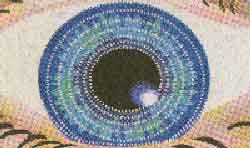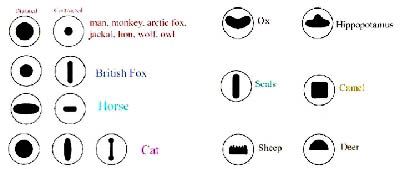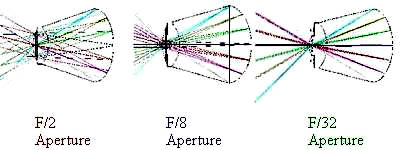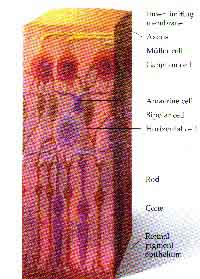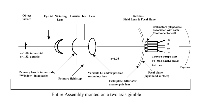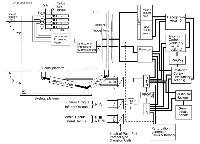lined links below to go to Subjects in Text)
Chapter 1. Vision System Design
A.
Importance
of
eyes - How and why
we see?
1. How
we see
2. Why
we see
B.
Optics
and image
processing requirements in Biological
eyes
1. Brain
intelligence
2. Brain-guided
eye
platform
3.
Hardware
and
software
interactions
4. Eye
arrangement for
stereo vision
C.
Optical
system
designs in Biological eyes
Chapter 2.
Biological Eye
Designs
Chapter 3.
Eye Design
Illustrations
Chapter 4.
Eye
Reproduction
Chapter 5.
Optical
Systems Design
Chapter 6.
The
Eye Designer
Related Links
Appendix
A - Slide Show & Conference Speech by Curt Deckert
Appendix
B - Conference Speech by Curt Deckert
Appendix
C - Comments From Our Readers
Appendix
D - Panicked Evolutionists: The Stephen Meyer Controversy
Chapter 1
Section A
Go to Chapter Links -
(Click on PICTURE IN TEXT to bring up LARGE PICTURE)
1. EYE DESIGN
A. Importance of eyes -
How and why we see
After millennia of recorded history, we are just beginning to
understand the complexity and diversity of eyes. Most living creatures
and some plants have individually designed eyes. Sight is essential for
most creatures. For most of us the eye provides the most important link
to the world by enabling us to visualize shapes and colors. Some
animals and plants only sense changes in light without seeing specific
images. The eye and brain process visual information to link our inner
being to the world and beyond.
1.
How we see
Eyes are adaptable visual sensors that enable us to see in a wide
variety of situations. While moving, images must be collected without
movements that cause blurred images. The electro-mechanical parts of
eyes near and around the lens provide a means of tracking, adjusting
light, and focusing. Tracking capability to control eye direction and
focus is required for the eyes of most creatures. Here the brain
controls where and how eyes see as well, as what they see. Brain image
processing software and hardware for eyes are more amazing than the
eyes themselves.
Scientists are just starting
to understand the complete process of vision. The following is a
diagram of a typical man-made image display system (Figure 1.1).
As an example of how we see,
consider the current generation of focal plane array sensors such as
charge-coupled devices in typical video cameras. They are also used
for military and commercial
infrared surveillance or visible viewing systems, optical missile
warning systems, and automatic optical target recognition systems.
These systems are much like our eyes. Some vision system optics and
light control appear to be patterned after a human eye as shown in
Figure 1.2. (From p. 135, Iridology,
Vol. 2, 1982, published by Bernard Jensen Enterprises,
Escondido,
CA 92027)
: (Clck link to LensShopper.com -- Interactive
animation of the eye's
anatomy)
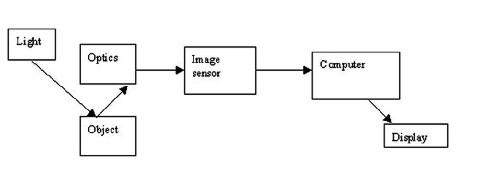
|
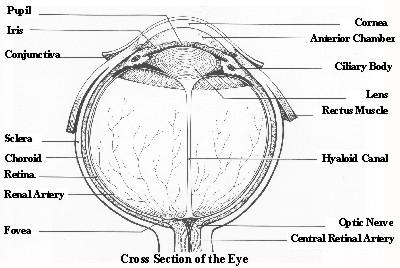
for a Biological Vision System (Like Figs.3-44 and 6-1) |
| There
are a number of vision system
parallels
as we see in the following comparison. |
|
|---|---|
| Part of Biological Vision System | Corresponding Part of
Man-made Vision System |
| Cornea: | Lens Optical window and focusing lens element for incoming light |
| Iris: | Iris that controls light level and background rejection |
| Retina: | Focal plane array like CCD detector in a TV camera to absorb and process radiation |
| Rods and Cones: | Photo detectors in focal plane array to convert photon into chemical and electrical signals |
| Plexiform ganglion cells: | Image processing on sensor to start to extract features of interest |
The
next figure then illustrates
a man made vision system

Scanning by one or more eyes
is sometimes used to increase field of view. Creatures with more than
two
eyes may use their multiple eyes for stereo vision and increased
angular
coverage. The brain coordinates the eyes to complete a vision system
that
may also require movement of related parts of the body. To help quickly
recognize danger and to visualize specific problems, image processing
of
eye signals to the brain involve at least the following:
Complex circuits
interconnecting the multitude of sensors in the retina.
Parallel
computersprocess
retina information for the brain to automatically
control eye functions such as light control and focus to provide
vision.
"Software" databases
that are present in the brain at birth for functions specific to that
type
of creature.
Recognition "software"
combined in small parallel computers for the brain to process
scenes.
Adaptable recognition
"software" for new situations as
learning takes place.
There are many different types and size of eyes. Some eyes of small
creatures
such as insects consist of arrays of many very small discrete sensors,
providing them compound eyes of various types. Here small sensors
contained
in each facet of a compound eye detect a small part of the total image
that is seen by each eye. Even by using today's technology, the optics
and image processing of these small eyes would be extremely difficult
for
man to duplicate in a lab, yet they are very common.
Billions of eyes are
produced in insects each year. Many variations in eye design are
represented.
How
many eyes came from evolution and how many came from a single
intelligent
design source?
Cell factories making
eyes take significant organization to duplicate DNA and create new
cells.
Every cell in the body contains directions for making eyes as well as
any
other body part. Cell design and multiplication is done with
intelligence,
control, and focused power inputs.
What
is the probability of eyes evolving without intelligent input?
How did the directions for making
eyes
DNA achieve a stable design?
How did
eyes from evolution reproduce?
Good color vision
is not evident in all species. Most creatures have some color sensors
with
enough resolution to recognize objects of different colors. Some have
capability
to see additional colors at one or both extremes of the human visual
spectrum.
For example, a number of insects such as moths and bees see ultraviolet
colors not visible within the human spectrum of vision. There are also
snakes such as vipers that see well into the infrared spectral region
where
humans cannot see without the help of special IR sensing instruments.
See
Figure 1.4 for spectral coverage of human eyes.
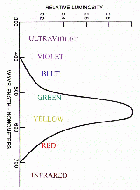
Coverage of Human Eyes. |
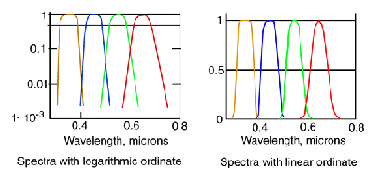
|
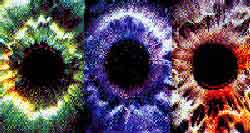
Iris Variations |
Light Into Eye Showing Several Different Size Apertures. |
|
The iris automatically
reduces the diameter of camera-type eyes opening to the eye lens and
retina
so the brain can control the light going to the retina. The retina is
like
a multi-layer film. It contains several layers of chemical electronic
sensors
made into a near- spherical shape. In addition to the iris, there is
additional
control on the sensitivity of the rod and cone photo-sensors within the
multiple retina layers of our eyes as shown by Figure 1.7. As an
example of design in human eyes, the spacing of red and green cones in
the retina are optimized for discerning yellow, orange, or red fruit
against a green background (reference: Biophotonics International, June
2002, page 40). This is typical of mammals that eat fruit. The
selection of fruit does not require high-resolution of color so we do
not need a full complement of color sensors for that purpose as in a
typical digital camera.
Massive amounts of information from eye retinas are processed rapidly by our brain. In order for this to happen, there are thousands of parallel paths in each layer of sensor cells that allow information to be partially processed in the path from the eye to the brain. Once this information goes into the brain the final images are processed and then samplings of scenes may go into memory. Specific optical designs are evident in the eyes of each family of living creatures. Each eye is designed uniquely to fit each creature, and is adaptable to typical situations it will encounter. Although many complex forms of eyes have been around for a long time, there is little proof of significant design changes in basic optical design approaches for any biological organism. There is no specific biochemical mechanism, other than fully developed eye cells, by which it is possible to obtain beneficial mutations of new or intermediate eye types. (Fig 1.7b adapted from 1999 Eye Poster from Anatomical Chart Co. Skokie, IL) (Figs 1.7c-d by permission of James T Fulton, Dir of Research Vision Concepts) |
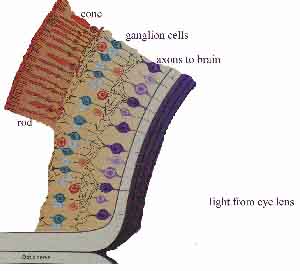
(Same as Fig 3.60b) Eye Assembly |
So how can "natural selection" create new eye designs from cell designs defined by a specific DNA?
The design integration of intelligence relative to eyes in all beings seems to have occurred rapidly with a high level of completeness and balance. There is not enough probability for any significant evolution in eye design to happen without adding intelligent input into the DNA alterations required to change eye cells. The initial DNA required considerable optical design input at all levels of eye development and image processing in the natural formation of eyes. The plan for eye formation is fully integrated at the cell level using complex molecular arrangements. Very specific DNA genetic codes work in millions of different creatures to reproduce and grow identical eyes in each type of creature.
Genetic codes are useless without specific processes fueled by energy and material and balance. The initial DNA required considerable optical design input at all levels of eye development and image processing in the natural formation of eyes. The plan for eye formation is fully integrated at the cell level using complex molecular arrangements. Very specific DNA genetic codes work in millions of different creatures to reproduce and grow identical eyes in each type of creature.
Genetic codes are also useless without specific processes fueled by energy and material sources to allow them to function. For example, a huge library is useless without someone to read and then use the material found in the books to do something constructive with it. This requires an assumption of initial intelligence to be able to read.
By being able to modify molecules in a controlled environment, scientists can study the basic building blocks of life to further appreciate the design that has gone into our eyes. DNA sequencing makes it possible to begin to read the directions for biological eye design at the molecular level. New research by scientists is providing new reasons to fund further study of biological eye designs.
Some scientists think it took hundreds of millions of years to evolve eyes yet eyes have more uniformity than many mass-produced cameras. We know man-made cameras do not just happen. Designers and manufacturers are required to establish uniform construction carried out with very specific materials and close tolerances, to fabricate parts for specific purposes. Manufacturing companies also require a purpose or market for the product. New engineering adapts it to changing conditions. There is usually no reason for engineers to perfect a technology until they know all the environmental and functional requirements.
In the real world there is no known random stream of beneficial mutations that develop products. The vast majority of mutations are neutral at best and lethal at worst. Significant intelligence is required for quality control to deal with negative mutations of typical designs and manufacturing.
Questions for Discussion
The high-resolution eyes of an eagle that spots distant targets
The large-aperture eyes of an owl who can see in the dark
The heat sensitive infrared eyes of a snake, which can spot a live target by detecting its body heat
The very wide angle eyes of a dragonfly for increased field of view
How would you integrate
and use any of these features in your vision system? I wonder if your
selection
will change as you explore this material on eye design? Or will you be
more satisfied at the capability of your own eyes and appreciate them
even
more?
As we examine theories of origins,
within
an eye design framework, we will be challenged by the variations of eye
design and technology.
What is the probability of eyes
evolving
without intelligent input?
How did the directions for making
eyes
DNA achieve a stable design?
